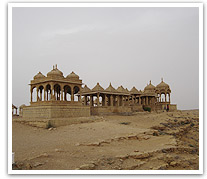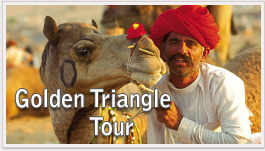Jaisalmer Tours
 Jaisalmer was founded by Rawal Jaisal in 1156 A.D. In 17th century, business and commerce flourished in Jaisalmer due largely to the opening of trade route between India and the rest of Asia. In those days goods were sent through camels to Middle East via Jaisalmer.
Jaisalmer was founded by Rawal Jaisal in 1156 A.D. In 17th century, business and commerce flourished in Jaisalmer due largely to the opening of trade route between India and the rest of Asia. In those days goods were sent through camels to Middle East via Jaisalmer.
Just like other towns of Rajasthan, Jaisalmer was also built centering around the fort or Sonar Kella. To the south of the town there is 76m high Trikut Hill and a fort is situated on it. The security arrangement of the fort is really unique. There are 99 towers, some of which possess canons even today.
Inside the fort there is the Juna Mahal which is famed for its lattice work. To the west is Jenana Mahal. On the upper part of the Hawa Pole there is Rang Mahal which is decorated with glass and murals. The glass mosaic designs of Sarbottam Bilas is a stupendous architectural specimen. The Mote Mahal or Flower Palace in the days of yore used to be the King's Durbar Hall or meeting place. There is also the magnificent Badal Bilas or The Tower of Clouds.
Jaisalmer Sightseeing
Jaisalmer Forte :- Jaisalmer Fort is the most alive of any museum, fort or palace that you are likely to visit in India. It was built in 1156 by the Rajput ruler Jaisala. About a quarter of the old city's population resides within the fort walls. The fort is entered through a forbidding series of massive gates leading to a large courtyard.The fort stands proudly amidst the golden stretches of the great Thar Desert, on Trikuta Hill, and has been the scene of many battles. Its massive yellow sandstone walls are a tawny lion color during the day, fading to honey-gold as the sun sets, thereby camouflaging the fort in the yellow desert. For this reason, it is also known as the "Golden Fort"
Nathmal Ji Ki Haveli :- Nathmalji-ki-Haveli was constructed by the two brothers, Hathi and Lulu who were famous for their unique architectural creativity. One of the notable Jaisalmer attractions, Nathmalji-ki-Haveli primarily served as the residence of Diwan Mohata Nathmal who was the Prime Minister of the place during that period.This haveli is still considered the best in Jaisalmer in terms of grandeur.The architecture present in this haveli is quite different from the one popular in other parts of Jaisalmer. The workmanship of Jaisalmer havelis is an amalgam of both Rajput architecture as well as Islamic art that was imported via the traders' caravan through the desert.
Patwon-Ki-Haveli :- This is one of the largest and most elaborate havelis in Jaisalmer and stands in a narrow lane. It is five storey high and is extensively carved. It is divided into six apartments, two owned by archaeological Survey of India, two by families who operate craft-shops and two private homes. There are remnants of paintings on some of the inside walls as well as some mirror work.This is the largest Haveli in Jaisalmer and stands in a narrow lane. This haveli is presently occupied by the government, which uses it for various purposes. The office of the Archeological Survey of India and State art and craft department is situated in the haveli itself.
Salim Singh Ki Haveli :- This haveli was built about 300 years ago and a part of it is still occupied. Salim Singh was the prime minister when Jaisalmer was the capital of the princely state and his mansion has a beautifully arched roof with superb carved brackets in the form of Peacocks. Like other havelis in Jaisalmer, this too has tuskers guarding the gateways. These are made of sand stones and look very close to the original in appearance. The haveli consists of as many as 38 balconies and they all have distinct designs for themselves. The front facet of the haveli resembles ship stern and thus this haveli is also sometimes referred as Jahazmahal.
Desert National Park :- The Desert National Park is situated in the Indian state of Rajasthan near Jaisalmer. The Desert National Park is a protected sanctuary. The park is considered not only the largest in the state of Rajasthan but among the largest in India. The catchments area of the Desert National Park is around 3100 sq. km. The desert is a harsh place to sustain life and thus most of the fauna and flora live on the edge. Nevertheless this place attracts large hoard of migratory birds due to its close proximity to Bharatpur.
Wood Fossils Park :- A 17 kilometer drive from Jaisalmer along the road to Barmer brings you to this park that takes you back to pre-historic times.It is a fossil park where stood a forest 180 millions years ago. The area submersed into the sea and the tree trunks got preserved in the form of fossils.The fossil trunks lie scattered in this park. Fossilized tree trunks are of various sizes with the largest being 13 meters in length and 1.5 meters in width. Covering about 10 sq. Km of bare hillside, the Fossil Park contains 25 petrified trunks, in total. The 21-hectare preserved area of the park lies about 17 Km from Jaisalmer on the road to Barmer.
Gadsisar Lake :- Built by a courtesan, it used to be the main source of drinking water in the olden times. Today, an arched gateway leads to a small tank flanked by shrines and well laid out gardens and flower beds. A scenic rain water lake with numerous beautiful shrines around. The lake is an idyllic spot for outings.
Gyan Bhandar :- Situated in the centre of the city, it was originally established as an adjunct to the famous Jain temples. But over the years it has accumulated a wealth of historical treasures. Some of the oldest manuscripts in the country are preserved here.
Haveli Museums :- Several owners of private havelis and the Department of Archaeology have taken over the task of preserving the work, murals, wall paintings and art treasures in most of the noted havelis. Of special significance are the painted murals in 'Patwari ki Haveli' and its specially polished pillars supporting a 5-storey high ceiling. 'Salim Singh Ki Haveli' has an arched blue roof and a surfiet of peacock shaped brackets.
Jain Temples :- Being the financers of Rajputs, the rich and influential Jain community was given full religious liberty; and they built many temples in and around Jaisalmer. With in the fort walls are a group of beautifully carved Jain Temples built between 12th and 15th centuries - dedicated to Rikhabdev and Sambhavanth.
Tazia Tower :- The delicate pagoda like Tazia Tower rises from Badal Mahal (Cloud Palace). Rising in its five tiered splendour, with each storey graced by a delicately carved balcony, the tower is of historical significance. Muslim craftsmen built it in the shape of a Tazia and gifted it to their royal patron.
Amar Sagar Lake :- Amar Sagar is a small and beautiful lake cum Oasis and is adjacent to a 17th Century palace called the Amar Singh Palace. Maharawal Akhai Singh built this palace in honor of one of his predecessors Amar Singh. Next to the palace are pavilions with a large stairs leading down to the Amar Sagar Lake. This haveli has been constructed in the pattern of apartments. The Amar Sagar is a five story high haveli and is famous for its murals. Wherever you go in this haveli, you will notice beautiful murals painted with delicate efforts. You can find many of wells and ponds in the surrounding which have a royal air about them. There is an old Shiva temple in the complex itself. Amar Singh built this because he was supposed to be an ardent follower of Lord Shiva, a Hindu God related to destruction.
Bada Bagh:- Bada Bagh, which literally means 'Big Garden', is located on the Ramgarh road. It was commissioned by Maharawal Jait Singh in the early 16th century and completed by his son Lunakaran after his death. The site has three different things to watch, a garden, a tank and a dam. In the vicinity itself you will find Govardhan Stambh (pillar). This pillar was constructed to commemorate the construction of the Dam and the tank. In the local dialect the Dam and the tank are known as Jait Bandh and the Jait Sar respectively. It is believed that these are based on the name of the man who constructed them. The Jait Bandh is a dominating structure. It is about 1,200 feet in length and 350 feet in width. If you observe it closely you will notice that this has been built out of solid blocks of stone. The same material has been used for the construction of well as well as the tank.
Lodurva:- Lodurva is the ancient capital of Bhattis Rajputs and was once a flourishing city but lost most of the splendor when the Bhattis shifted their capital to Jaisalmer. Nevertheless this place is a major tourist attraction and attracts a lot of attention due to ruins of Jain temples. The most mesmerizing experience will be the peacock dance amid exotic Lodurva ruins. Yes, Peacocks are a great pull and they are in plenty here. Lodurva is also known for its Jain temples. The temples are made of bright yellow sandstones. Though in ruins, the splendors of these Jain temples are clearly visible. You will find temple walls decorated with the pictures of Lord Parsvanath, the 23rd Jain Tirthankar. The beautiful Jaali works make these temples a piece of marvel. You will notice the splendid and dominating arch in the main temple building. These arches are typical of the Dilwara style of temple architecture.
Sam Sand Dunes :- Located at a distance of 42 kilometers from Jaisalmer, Sam Sand Dunes is the closest point to witness the total sandy desert. You can also see the patterns and motifs created by the shifting sands and air. Moreover, Sam Sand Dunes also provide you with an unforgettable experience of camel rides and the sunset

